Qualcomm Details Snapdragon 835: Kryo 280 CPU, Adreno 540 GPU, X16 LTE
by Matt Humrick on January 3, 2017 5:00 PM EST- Posted in
- Smartphones
- Snapdragon
- Qualcomm
- Adreno
- Mobile
- Snapdragon 835
- Kryo
During its presentation, Qualcomm highlighted six key areas of focus for Snapdragon 835: battery life, connectivity, security, photo and video, VR and AR, and machine learning. The common thread that ties all of these together is heterogeneous compute, which is deeply woven into the 835’s hardware design.
Battery Life
Power consumption and heat production are the primary constraints for any smartphone or mobile device activity, especially for the advanced workloads mentioned above. Despite promises of better performance, Qualcomm says Snapdragon 835 uses less power overall than Snapdragon 820. The shift to a 10nm FinFET process certainly helps, as does the shift in architecture for the Kryo 280 CPU. Qualcomm paid special attention to reducing the efficiency cluster’s power consumption, because, according to the company, the CPU spends up to 80% of its time running tasks on the lower-power cores. Optimizations to other areas, like the GPU, also help reduce power consumption in specific situations, and updates to Symphony System Manager give it finer grained control over voltage and frequency scaling.
Qualcomm says Snapdragon 835 consumes 25% less power than Snapdragon 820 and 50% less than Snapdragon 801, but that’s for an unspecified workload. In a phone with a QHD display and 3000mAh battery, the 835 should provide 3+ hours of continuous 4K video encoding and 2+ hours of VR gaming. The 835 also supports Qualcomm’s Quick Charge 4 fast-charging technology that promises up to 20% faster charging and 30% higher efficiency than the previous generation Quick Charge 3.
Connectivity
Snapdragon 835 includes an integrated X16 LTE modem that delivers up to 1Gbps (Category 16) on the downlink using 3x20MHz carrier aggregation and 256-QAM modulation. The higher downlink speed is achieved by using 4x4 MIMO on two aggregated carriers plus 2x2 MIMO on the third carrier to create 10 unique data streams. It also delivers up to 150Mbps (Category 13) on the uplink using 2x20MHz carrier aggregation and 64-QAM.
As the industry continues down the path towards 5G, Qualcomm sees gigabit-class LTE as an important bridge, providing higher bandwidth coverage over a wider area while operators work to bring short-range, millimeter-wave 5G networks online. To make this work, phones using Snapdragon 835 will need 4 cellular antennas (plus additional antennas for Wi-Fi, Bluetooth, NFC, etc., resulting in phones with 7-10 antennas). Due to limited space, OEMs will likely use smaller antennas for higher frequencies, limiting 4x4 MIMO to the mid and high bands between about 1.8GHz and 2.6GHz, while the lower bands use 2x2 MIMO. Carrier support for gigabit LTE is not widespread at this point (Qualcomm says carriers should begin rolling out network support in 2017), so it will be interesting to see which OEMs that use Snapdragon 835 actually include 4 antennas. Even if a network does not support 4x4 MIMO, the phone can still take advantage of 4-way receive diversity, like Samsung’s Galaxy S7, to improve signal strength.
Snapdragon 835 also supports 802.11ac Wi-Fi with 2x2 MU-MIMO, Bluetooth 5, and FM radio when paired with the WCN3990 companion chip. This is the first certified Bluetooth 5 solution, offering up to 2Mbps of bandwidth, which is twice that of BT 4.2, or up to 4x the range of BT 4.2. Other advantages include a 60% reduction in Wi-Fi power consumption relative to Snapdragon 820, and the ability for LTE/LAA/Wi-Fi to share antennas, reducing the total number of antennas in a phone by up to three. There’s also support for 802.11ad Wi-Fi at up to 4.6Gbps, although this remains a discrete solution that requires an additional companion chip.
Photo and Video
Smartphone OEMs are always looking for ways to differentiate their products. Several years back software was the focus; then it was bigger, higher resolution screens; then materials and design; and now it’s the camera. In 2016 we saw several flagship phones incorporate dual rear cameras, a trend that will continue to gain momentum this year.
Snapdragon 835’s Spectra 180 ISP, which supports dual 16MP cameras, gives OEMs the ability to use two lenses with different magnification ratios, like the iPhone 7’s wide-angle and 56mm lenses or the G5’s wide-angle and fisheye lenses, and use its “Smooth Zoom” feature to switch between them. OEMs can also use Qualcomm’s Clear Sight algorithm to combine the output from two different camera sensors. The first sensor captures color data using an RGB Bayer color filter array, but the second black and white sensor, which is used to gather luminance data, does not, allowing it to capture significantly more light. This technique promises to produce a brighter image with better contrast and less noise than one taken with a single color sensor.
Snapdragon 835 continues to support Google’s Halide language for hardware accelerated image processing using the Hexagon 682 DSP. Google took advantage of this feature in Snapdragon 820 to enhance image quality when using the Pixel’s HDR+ camera mode. The 835’s DSP can also be used for face detection and recognition when using the camera. OEMs can use this to enhance autofocus performance by quickly locking onto faces or to apply beautification algorithms.
Because many of these advanced imaging features require significant hardware and software development, Qualcomm is introducing its Snapdragon Camera Modules. These prefabricated, integrated hardware/software modules are already tuned and ready to use, giving OEMs faster time to market—and more incentive to implement new features—by significantly reducing the engineering effort. There are three modules currently available, including a single camera with PDAF and two dual-camera configurations covering both options discussed above.
Snapdragon 835 includes new video capture and playback capabilities too. The 835’s VPU and DPU can now decode and display 4K Ultra HD premium (HDR10) video. The DPU is capable of outputting 2160p60 video with 10-bit color to a wide color gamut 10-bit internal or external display, although we have not seen any 10-bit panels for mobile devices yet. The DPU also supports Q-Sync, which allows a Q-Sync capable display to refresh as quickly as the GPU can render frames.
Snapdragon 835 can also decode H.264 (AVC) and H.265 (HEVC) video at up to 2160p60, 1440p120, or 1080p240. Video encoding tops out 2160p30, 1440p60, 1080p120, or 720p240. Just like Snapdragon 820, the 835 uses EIS 3.0 video stabilization but includes new trajectory smoothing algorithms.
Virtual Reality
Qualcomm continues its push into virtual and augmented reality with Snapdragon 835, targeting both dedicated HMDs and smartphones with Google Daydream support. VR’s combination of high-resolution 3D visuals, positional audio, spatial tracking, and gesture recognition place a significant burden on an SoC, requiring good performance and tight coordination between each onboard processor. One of the many challenges in creating a believable virtual environment is motion to photon latency. Qualcomm says Snapdragon 835’s latency is 15ms, down from 18ms for Snapdragon 820, reducing the lag between head and scene movement that can cause motion sickness.
Qualcomm’s Visual Inertial Odometry (VIO) system for head motion tracking uses the Hexagon 682 DSP to process streaming video from a camera at ~30 fps and the All-Ways Aware DSP to capture accelerometer and gyroscope data at 800Hz or 1000Hz. It then combines this data to determine position and orientation in 6 degrees of freedom. Qualcomm says using the DSPs for this function is almost 4x more power efficient than using the CPU.
Qualcomm sees computer vision as another key component of VR and AR. Eye tracking aids foveated rendering, where objects centered in your field of view are rendered more sharply, and could provide another way to interact with a user interface. Gesture recognition allows you to interact with virtual objects without the need for physical controllers or accessories. The computer vision data from the DSP could also be an input to the GPU for rendering virtual hands, improving immersion within the virtual world.
Machine Learning
Machine learning is the new “killer app” for mobile, powering everything from computer vision to intelligent assistants. Qualcomm’s Snapdragon Neural Processing Engine SDK takes advantage of the 835’s heterogeneous compute capabilities when executing neural networks. New capabilities in Snapdragon 835 include support for customer created neural network layers and support for TensorFlow, an open source library for performing machine learning using data flow graphs. Qualcomm says Snapdragon 835’s Hexagon 682 is the first mobile DSP to support both the TensorFlow and Halide frameworks.
Qualcomm remains focused on using heterogeneous compute to enable new experiences, such as VR/AR, intelligent assistants, and advanced imaging. Snapdragon 835 is a logical extension of the 820 in this regard but does offer several improvements. The move to 10nm FinFET, a new CPU architecture, and tweaks to the other processors should result in a higher-performing and more power efficient SoC, but we’ll need to verify those claims with our own testing. Other notable additions include the X16 LTE gigabit-class modem and support for 4K Ultra HD premium video display.
Snapdragon 835 is in production now and will begin shipping in commercial products in the first half (or probably quarter) of 2017.


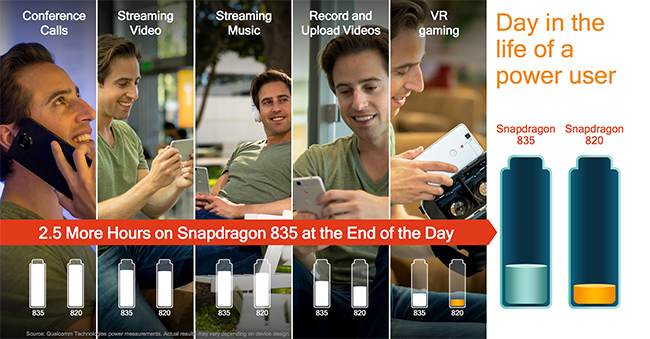
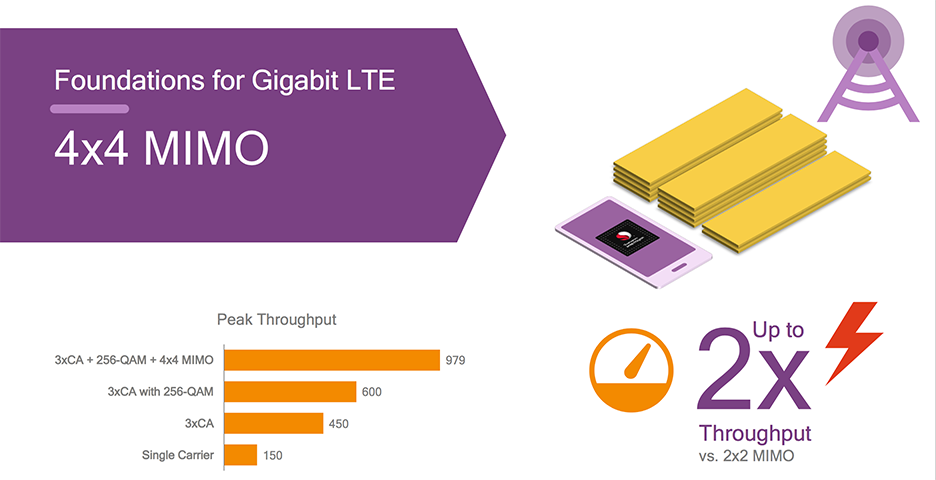
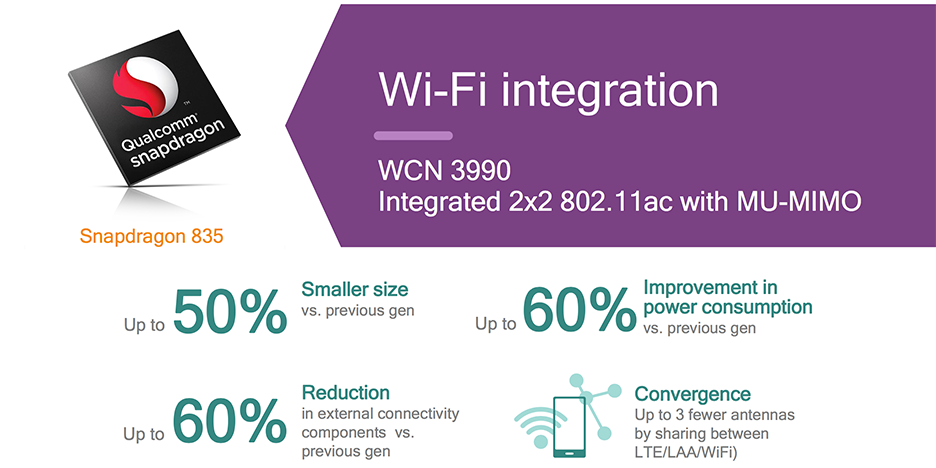
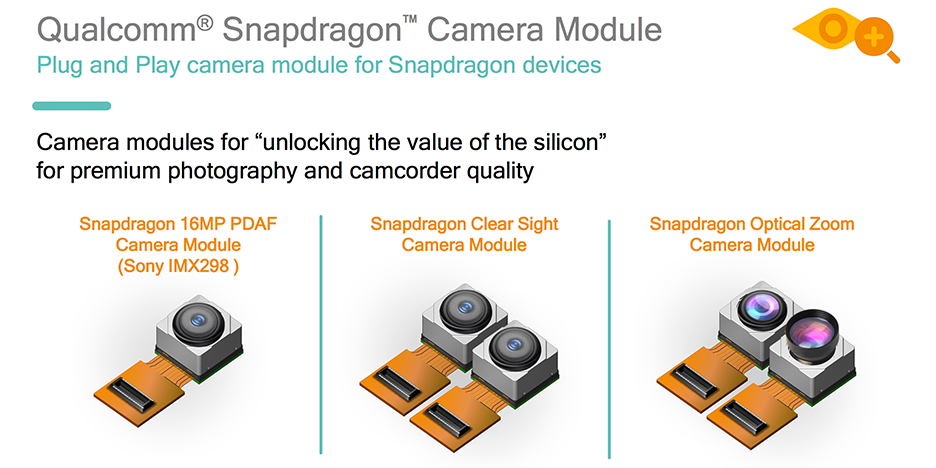
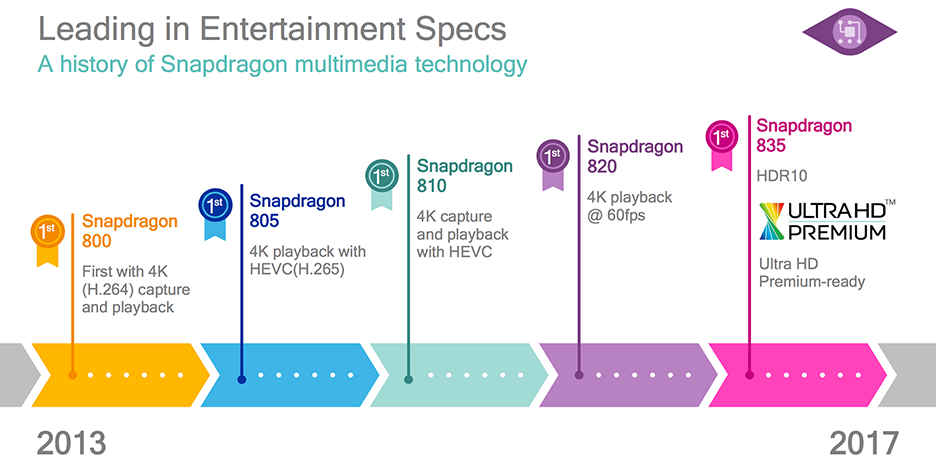
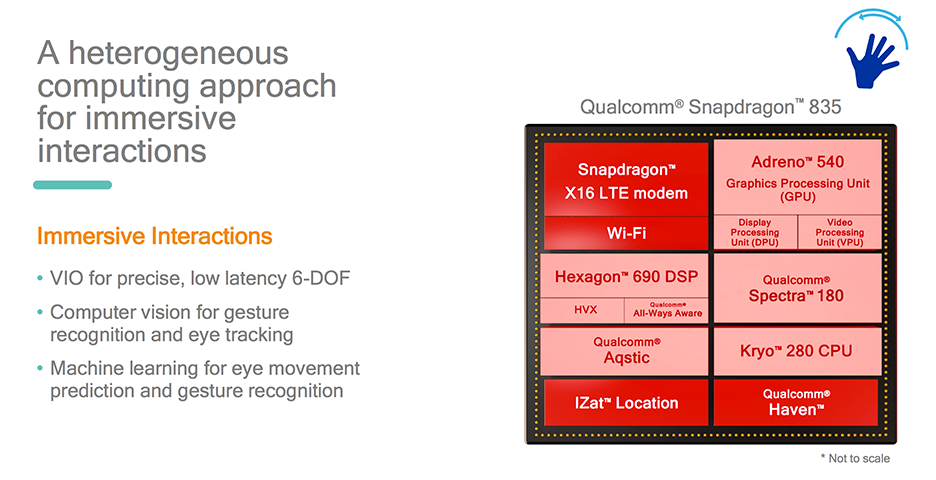
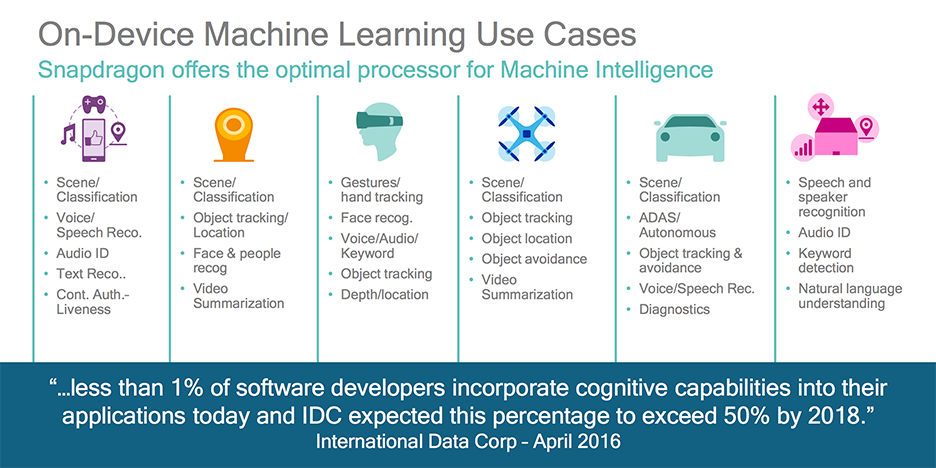








58 Comments
View All Comments
colinisation - Saturday, January 7, 2017 - link
I think the custom core buzz was because Qualcomm beat outgeneric ARM cores in the past - think Cortex A8/9 vs Scorpion but also Cortex A15/57 lest a bad taste in peoples mouths when compared to Apple's cores at the time and the popular refrain was "its because they are generic ARM cores". I however thinks things have moved on since then and ARM has poured more resources into their custom cores and A72/73 are more focused on mobile as opposed to being a bridge to the server world.I agree with you on the common workloads front - have you got any links for the claim on Kirin 960 vs 8890. I know Huawei are trumpeting their Cortex M7 integration.
I think in order to properly bench these things you would need to dismatle phone connect it up to a voltmeter and power source to determine how much power is being draw then run it through a number of scenarios - web browsing, gaming, app installs etc Before measuring power draw, app opening speed, performance, responsiveness and then calculate how long it will last given its battery size. This is a LOT of work and not sure its reasonable to ask review sites to put that much time into 1 review
lilmoe - Sunday, January 8, 2017 - link
The Cortex A9 was significantly faster than Scorpion. It wasn't until Krait that Snapdragons really closed the gap, barely. Krait Snapdragons benched better, but Cortex A9 Exynos processors were simply faster and more fluid running as a whole (they got a bit toastier at times though)."I think in order to properly bench these things you would need to dismatle phone connect it up to a voltmeter and power source"
I wish it were that simple. You just can't build a conclusion on any sort of systematic/synthetic test. Even if it were a browser script which is supposed to simulate "real life". Browsing habits differ by user, and the browser used and the governer the OEM implements (among other "secret sauce" ingredients) make a bigger impact than processor efficiency on the readings of your measuring equipment and/or on overall system battery life.
"have you got any links for the claim on Kirin 960 vs 8890"
My opinions are generally made from personal, real life experience. I have lots of friends that try out different phones and we usually spend hours comparing.
But technically speaking, do we really need proof? There's one fact that EVERYONE fails to realize (especially Andre here, the rest of Anandtech don't seem to care); ALL of these processors are mainly running on the small cluster!!! Both the Kirin and Exynos are mostly running on the same 4 Cortex A53 cores. The big/performance cluster works for split seconds and goes back to sleep, mostly when loading a page, or launching an app.
That being said, there are 2 main things that make Exynos SoCs better than Helios and Kirins IMO:
1) The interconnects and co-processors are simply better. Samsung's fixed function video decoder, in particular, is industry leading in performance and efficiency (it's been this way since the Hummingbird in my experience).
2) Two of the M1 cores are always offline. They don't come online unless needed. Not sure how much this makes an impact, but the Kirin has all 8 online at all times.
A simple Youtube search shows lots of battery tests between the Exynos GS7 Edge and the Mate 9. The GS7 has better battery life even with a smaller battery.
I won't be upgrading my GS7 until we see an upgrade to the A53 core.
SarahKerrigan - Tuesday, January 3, 2017 - link
Is Kryo 280 definitely a Cortex derivative? It seems really weird that they'd call it a Kryo instead of stating outright that it was an enhanced A73 or something...shabby - Tuesday, January 3, 2017 - link
Probably don't want to admit that the a73 is better than their offering so they went this route and used a slightly tweaked a73 and don't have to divulge any other info about it.prisonerX - Wednesday, January 4, 2017 - link
The terms of the licence dictate that it is indeed a Cortex derivative, and almost all Cortex. The name is pure marketing.name99 - Wednesday, January 4, 2017 - link
More interesting is the issue of what this means for the QC Server chip.Did QC conclude there's more money and less competition in ARM servers, so moved the Kryo team there? Because this movie certainly seems to suggest that they've given up trying to really compete in the ARM CPU space --- now they'll just compete, presumably, on the basis of Hexagon, Adreno, and wireless, but with essentially the same CPU as everyone else?
prisonerX - Wednesday, January 4, 2017 - link
It could just be priorities and the fact they can't do better than ARM's design in the short/medium term. ARM's design may be getting better as they bring more resources to bear or the design cycles too long at this point to have their own design.The server space is ripe for "disruption." Desktops and PCs generally are slowly going the way of the dodo and the future is mobiles and servers. People aren't going to let Intel keep such a strategic segment all to themselves. Single thread performance is flat and power consumption is king and they know Intel is vulnerable. The hyenas are nipping at the wounded and bleeding former lion king.
lilmoe - Wednesday, January 4, 2017 - link
Or it simply means that instead of focusing solely on how to achieve the highest brute performance for a given TDP, one should focus more on efficiency of a specific performance target and work more on offloading more tasks to dedicated blocks and co-processors that the very best CPU architecture can never dream to achieve.Which is exactly what they did, and what I believe is the right thing to do. You guys are focused on the wrong thing for the wrong form factor. This isn't desktop computing. Heck, even desktop CPUs are moving in that direction. After a certain performance threshold, CPUs get less and less important.
lilmoe - Thursday, January 5, 2017 - link
And just to add something I've been saying over and over for a while. What Qualcomm, Samsung and ARM should be focusing on from this point is NOT the high performance cluster, but the efficiency cluster. The A53 is in dire need for a refresh. If you guys want to focus on the CPU aspect, you need to start focusing on this. Qualcomm are saying that the small cluster is handling 80% of the workload alone; I say 90%. That 1MB of L2 they slapped on the small cluster might mean all the difference they needed on the CPU side.jospoortvliet - Thursday, January 5, 2017 - link
Well there is the a35 already...